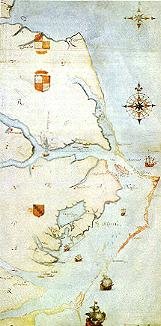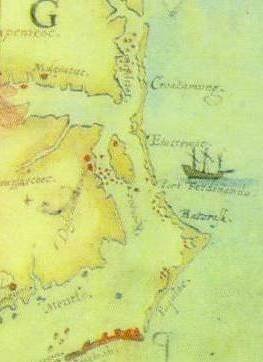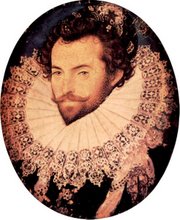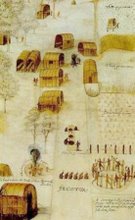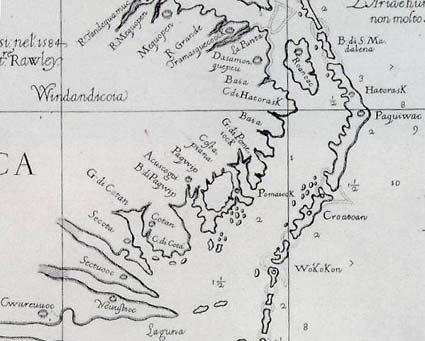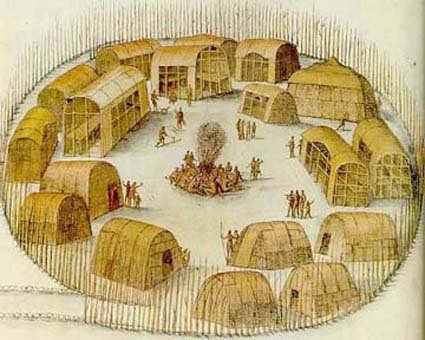Dateline: 08/25/99 (News updated July 24, 2001)
Modern hunters have discovered the remains of an ancient hunter at the edge of a remote glacier near the Yukon - British Columbia border.
The group who made the discovery are all teachers from the Nelson, British Columbia area. On August 14, they were hunting for Dall sheep in British Columbia's Tatshenshini-Alsek Provincial Wilderness Park (special permits are available for hunting in the park) when one of them, Bill Hanlon, noticed the first piece of wood they had seen for miles. It turned out to be part of a carved walking stick, and further examination of the area by Hanlon, Warren Ward and Mike Roch resulted in the discovery of other artifacts and a headless body. Following a 2-day hike out, they contacted the Beringia Centre at Whitehorse to tell of their find. Government archaeologists, of course, flew immediately to the scene.
The body and artifacts (including the walking stick, a finely-woven cedar hat, a spear-thrower called an atlatl, and a leather pouch containing edible leaves and the remains of a fish) have now been flown to Whitehorse and put into a freezer room to prevent deterioration. The removal of the body and artifacts from the glacier was accomplished by a team that included forensic anthropologist Owen Beattie of the University of Alberta, as well as Yukon government archaeologists, a glaciologist, an artifact conservator and representatives of the Champagne-Aishihik First Nation (CAFN), in whose traditional territory the discovery was made.
As is so often the case with such discoveries, CAFN immediately turned the find into a political issue. Spokesman Ron Chambers stated today (Aug. 25) that the discovery proves the long-term use of the land by First Nations people (thus presumably strengthening their position on land claims). CAFN had held up official news of the find for 10 days while government representatives held discussions with CAFN elders regarding possible ways of dealing with the discovery. The elders agreed to a scientific study of the remains and have given him the title of Kwaday Dän Sinchi, meaning "long ago person found". (September 28, 1999 update - artifacts radiocarbon dated to 550 years BP).
The Aug. 25 edition of the Yukon News quotes CAFN chief Bob Charlie:
"The elders have indicated that we should use this situation, what appears to be an ancient tragedy, to learn more about this person, when he lived and how his clothes and tools were made and how he died," said Charlie. This person will have much to tell us, to help us understand our past, and the history of our homeland. We wish to see these human remains treated with dignity and respect and to see the most positive outcome of this long-ago event."
In fact, the band see the find as more than a cultural boon. It's already planning to tap into research grants that will help pay its members to study the remains.
The Yukon government has stated that an agreement to turn over artifacts (including bodies) to the First Nations would be honoured. However, the find was made in British Columbia, and the cedar hat, although possibly an item obtained in trade with coastal people, may also be an indication that the ancient hunter lived near the coast, not in the interior, so that statement may be premature. It is entirely possible that the man lived in what is now Alaska (and was just passing through BC on a hunting trip or on his way to the interior), and I expect that the Alaska government will be getting involved very soon. While this is not a case of body theft, if the man can be reasonably assumed to be Tlingit or from an even earlier coastal culture, a repatriation request will likely be forthcoming.
http://explorenorth.com/library/weekly/aa082599.htm
B.C. ice man find revisited
April 25, 2008
Above: The team of scientists at the discovery of Long Ago Person Found site in 1999. Right: Kjerstin Mackie, a textile conservator at the Royal B.C. Museum, examines the remain of a robe.
Public invited to hear summary about ‘Long Ago Person Found’
Al Mackie remembers well the moment he got the call about a discovery in the farthest reaches of Northwestern B.C.
It was Aug. 21, 1999. Initial information given to Mackie, a Victoria-based scientist with the B.C. Archaeology Branch, was that a pair of hunters out tracking sheep on a glacier in Tatshenshini-Alsek Park, had stumbled upon well-preserved human remains.
Not just any human remains, but those of an individual who was clearly from another time and quite possibly another place. Within two days, the appropriate calls had been made to the Champagne and Aishihik First Nations – on whose traditional lands the remains lay – and a team of scientists were dispatched to the site to expedite the removal of the remains.
“They’re fine when they’re in the ice. But at the moment that these kind of materials thaw is the moment they start to decay,” said Mackie, who worked two years full time on the project and was a key go-between working with the other interested parties.
“There was considerable urgency to recover the remains,” he recalled. “That was the first agreement we made; get them out, put them into a freezer and then sit down and talk about what we’d do from there.”
Nearly nine years later, the research continues into the discovery of Kwäday Dän Ts’inchi, as the find became known – it means “long ago person found” in the Southern Tutchone language.
As part of this week’s Northwest Anthropological Conference at the University of Victoria, the Kwäday Dän Ts’inchi Symposium will see experts in fields ranging from forensic anthropology to cultural history to ethnobotany rehash the most minute scientific discoveries in the project, and touch on the far-reaching cross-cultural issues.
http://www.bclocalnews.com/vancouver_island_south/saanichnews/news/18144764.html
Globe and Mail, CanWest News Service: The BC Iceman (as in Brit. Columbia)
Found thawing from glacier, his genes make him family for living members of Canada’s First Nations. Nine years ago, far up in the northwest corner of British Columbia near the Yukon and Alaska borders, three hunters seeking Dall mountain sheep instead found a young man’s body emerging from a thawing glacier. He’d apparently been in the ice for several hundred years.
Soon he was dubbed the BC Iceman. The body had been sheared by glacial movement but was in fairly good shape. So were tools and clothes including a gopher skin blanket and a woven hat. More formally, he’s Kwaday Dan Ts’inchi or Long Ago Person Found in the Tutchone language.
Now a reunion of sorts is being celebrated. Canadian news outlets are carrying news, from a science conference in Victoria, that his genes indicate affinity to 17 people alive today. Fifteen of the 17, it says here, are from the Wolf Clan. They are among 240 members of native Champagne and Aishihik peoples who volunteered to be tested (the community appears to be deeply interested in archeology). All live in nearby regions of northern BC, Yukon, and Alaska.
For this first burble of news reporters tended to focus, naturally, on the delight felt by some of those who are either descendents of the fellow or of some of the members of his immediate family. It seems, from some of the background gleaned this morning (see Grist) that this story deserves a much broader treatment. That is, people have been working pretty hard to put the man’s story together. It’s a saga.
http://ksjtracker.mit.edu/?p=6171
Abstracts:
http://www.kdtsymposium.bc.ca/Content_Files/Files/kdts/Authors_abstracts_current_ready_April23.pdf
One of the research projects involved sequencing of Kwäday Dän Ts’ìnchi’s mtDNA, which revealed that it belonged to Haplogroup A, with the polymorphisms 16111T, 16189C, 16223T, 16290T, 16319A, and 16362C.
http://www.isogg.org/ancientdna.htm
http://www.thegeneticgenealogist.com/2008/04/27/kwday-dn-tsnchi-long-ago-person-found/
Journal Canadien d'Archeologie pdf doc.
Download here:
http://www.kdtsymposium.bc.ca/Content_Files/Files/kdts/beattie_et_al_ocr_small.pdf
The BC Iceman's remains were reportedly returned to the two tribes claiming ownship. They were cremated and reburied. Hopefully DNA samples were retained. If his Y chromosome is known, that information would be deeply appreciated.
History Chasers
Wednesday, April 30, 2008
Saga of the BC Iceman
Posted by
Historical Melungeons
at
4/30/2008 05:26:00 PM
![]()
Labels: aishihik, alaska, bc iceman, champagne tribe, first nations, yukon
Tuesday, April 29, 2008
English Delegation Visits Manteo, Jamestown and Williamsburg
By JON CAWLEY
5:17 PM EDT, April 28, 2008
JAMES CITY - The first ever visit by an English delegation from the town of Bideford to their sister-city of Manteo, North Carolina, will end Wednesday after a trip to Jamestown Settlement and Colonial Williamsburg.The group includes Bideford's Mayor, his wife and 17-year-old daughter along with the town's vice mayor and two residents. They arrived in Norfolk on April 23 and have since been meeting their North Carolina contemporaries and seeing the sights of coastal Manteo, just inland from the Outer Banks, said Bryant Brooks, a Dominion Virginia Power spokesman. Brooks said Dominion's involvement stemmed from "wanting to be good corporate citizens" and included trip coordination between the Virginia and North Carolina locales, where the power company has a widespread service area on both sides of the border.Brooks said the trip marked the first official visit to Manteo by a Bideford delegation.
A group of Manteo representatives toured Bideford on a similar trip about 10 years ago, he said.
A historic tie between the two towns extends to the late 1500s when Sir Walter Raleigh sailed from Bideford to Roanoke Island — a site that later became known as the Lost Colony after its inhabitants inexplicably disappeared.
cont. here:
http://www.dailypress.com/news/local/williamsburg/dp-local_english_0429apr29,0,7165613.story
Posted by
Historical Melungeons
at
4/29/2008 10:29:00 AM
![]()
Labels: bideford, lost colonists, manteo, north carolina, outer banks, Raleigh, Raleigh's colonists, Roanoke island
Sunday, April 27, 2008
THE UNITED KINGDOM AND IRELAND
The UK and Ireland are regarded, for the purposes of this Genealogical Information Service, as being made up of England, Ireland (i.e. Northern Ireland and the Republic of Ireland), Wales, and Scotland, together with the Channel Islands and the Isle of Man. Together, these constitute the British Isles - which is a geographical term for a group of islands lying off the north-west coast of mainland Europe. (Legally, the Channel Islands and the Isle of Man are largely self governing, and are not part of the United Kingdom.) The Administrative Regions into which the UK and Ireland are divided have changed frequently in recent years. However, in line with normal genealogical practice, this Information Service is structured according to the counties as shown in these maps of England, Scotland and Wales, and of Ireland, i.e., as they were prior to the re-organisation that took place in 1974 (1975 for Scotland).
Posted by
Historical Melungeons
at
4/27/2008 10:08:00 PM
![]()
Labels: GENUKI, Research UK and Ireland
Journal of Southern History, April Lee Hatfield
Spanish colonization literature, Powhatan geographies, and English perceptions of Tsenacommacah/Virginia.
IN 1612 VIRGINIA COLONIST WILLIAM STRACHEY EXPLAINED THAT HIS Historie of Travell into Virginia Britania depicted in greatest detail that part of the Virginia Company's claims where the English had concentrated their colonizing activities. This area, as Strachey described it, was roughly contiguous with the "severall territoryes and provinces which are in chief commaunded by their great king Powhatan, ... comprehended under the denomynation of Tsenacommacoh, of which we may the more by experyence speak being the place wherein our abode and habitation hath now well neere sixe yeares consisted." Ten years later Englishman John Martin wrote, "That parte of Virginia wthin wch wee are seated and fitt to be settled on for many hundred yeares: Is wthin the Territories of [Powhatan's successor] Opichakano, ... whoe Comaundeth from the Southermost parte of the first [the James] River to the Southermost parte of the fourth River called Patomeck.... In longitude it extendeth to [the] Monakins Countrie ... west and west and by North...." The two writers used very similar boundaries to demarcate the English colony: the James River, the Atlantic Ocean, the fall line, and (in Martin's case) the Potomac River. (1)Neither the official extent of the Virginia Company's claims nor the actual reach of English settlement, however, explains Martin's and Strachey's descriptions of Virginia's boundaries. The colony's second charter in 1609 granted the Virginia Company land two hundred miles north and south of Point Comfort, and from sea to sea. Virginia's English population occupied only a small section of the James River when Strachey wrote, and more of the James and some of the Eastern Shore when Martin wrote. (2) A half century later the extent of Virginia's population, its dependence on tobacco cultivation and export via Chesapeake waterways, and the establishment of Maryland north of the Potomac would suggest these borders for the English colony, but the 1612 English population of about 500 and the 1622 population of just over 1,200 were not nearly enough to require the area encompassed by Strachey's and Martin's descriptions. (3)
Read complete article here.
COPYRIGHT 2003 Southern Historical Association
Posted by
Historical Melungeons
at
4/27/2008 06:56:00 PM
![]()
Labels: Powhatan, Spanish colonization, William Strachey
New World Seen With an Old World Eye
You can view the difference between John White's paintings and the corresponding De Bry engravings here:
http://www.virtualjamestown.org/images/white_debry_html/jamestown.html
At the Yale Center for British Art, rare paintings and engravings are put to the truth test in 'A New World: England's First View of America.'
By Paul Lieberman, Los Angeles Times Staff Writer April 27, 2008
NEW HAVEN, CONN. -- VISITORS who pass quickly by may detect nothing unusual about the 500-year-old woodcut of Brazil's Tupinamba Indians, shown in decorative feathered garb. But those who stop and examine it will certainly notice the severed arm in the background -- and someone about to gnaw on it. In this early depiction of the New World, made following a Portuguese explorer's trip, the natives are cannibals."People in Europe thought the unknown world was full of monsters and very frightening savages," said curator Elisabeth Fairman, leading a group past the 1505 woodcut on the wall of the Yale Center for British Art.
The frightening scene is just a setup for very different scenes to come -- in the historic watercolors that gave Britain and much of the world its first images of what became known as America, images used to this day to teach school children what Native Americans looked like and how they lived before Europeans put their stamp on this land."These are the 18 drawings . . . the iconic images everyone knows," Fairman said as the group stood before colorful renditions of friendly Indians in a land of plenty. Fish virtually jump from the water into their canoe. Corn grows in neat rows. Families wave. People sit around a fire. A dog romps. is that these images -- part of "A New World: England's First View of America" -- are something else.
"Propaganda," said Fairman, the Yale museum's curator of rare books and manuscripts. Or perhaps they can be seen, more charitably, as a limited snapshot of a small group of people at a short-lived moment -- right before the clash of cultures began to take its toll.
The watercolors were the work of John White, a British gentleman who was on several voyages sponsored by Sir Walter Raleigh to the coast of what was then called "Virginia" -- after England's Virgin Queen, Elizabeth -- but is now North Carolina.
White's watercolors provided visions of Native Americans that would be viewed as near gospel for two centuries, but they were based on a mere two-week encounter with one tribe, the Algonquians, during a 1585 voyage to establish an English military presence in the New World. Two years later, White returned to lead a delegation of 115 civilians, hoping to establish a permanent settlement at the "Cittie of Raleigh," that group including his daughter Eleanor Dare, who gave birth to the first English child born in North America, the aptly named Virginia Dare.
White then left them behind to go back to England for more supplies and by the time he returned, in 1590, there was no trace of them -- not his daughter, granddaughter or any member of what became known as the "Lost Colony of Roanoke."So the settlers vanished, but White's watercolors endured, thanks to their use in illustrating popular books on the New World whose text ("A Briefe and True Report of the New Found Land of Virginia") was written by mathematician Thomas Harriot, who also was on the 1585 expedition.
Of course, that was long before there was technology to easily duplicate a painting. Mass reproduction in this case was achieved through engravings made by a Belgian goldsmith, Theodore de Bry, whose images of the same Indians also are part of the exhibit.And there's the catch -- the engravings made by De Bry took liberties with White's original watercolors, pushing them in a clear direction. While the Native Americans were shown as benign to start, De Bry made them even more palatable to audiences back home and clear candidates for conversion to Christianity.
One stunning example is White's "Indian Man and Woman Eating" ("Their Sitting at Meate"), showing the pair squatting around a platter of what appears to be boiled corn. But they are squatting in a way that may have seemed uncomfortable to the British audience, so the engraved version has their legs stretched out; and their facial features appear European.
Another White watercolor shows an "Indian Woman and Young Girl," with the mother looking off into the distance and the girl holding a doll that's obviously a gift from the visitors from across the ocean. In the engraving that became the circulated image, "A Cheiff Ladye of Pomeiooc," the mother's gaze is redirected at the girl, who now is playing not only with the doll but a Western rattle.
The message to the folks back home: These people may dress differently than we do, but they are not all that different."What he's paying attention to," Fairman said of White, "is how they eat, what they eat, how they catch their food, how they treat their children, how they interact with each other . . . and how you tell who's in charge, who the priests are . . . all the kind of information people in the Elizabethan court, and the people on the next voyages, need to know."
Full Article Here:
http://www.latimes.com/entertainment/la-ca-yaleart27apr27,0,3125192.story
Posted by
Historical Melungeons
at
4/27/2008 10:16:00 AM
![]()
Labels: indians, john white, lost colony, Raleigh, watercolors
Wednesday, April 23, 2008
The Tuscarora War, 1711-1715
Throughout this period the Bear River and Machapunga Indians continued their petty annoyances, and the settlers continued to petition the government for something to be done about the situation. Little seems to have been though for the settlers remained prey to roving bands of Indians who would enter a settler's home, ransack it, kill his hogs, and assault him if he protested.
Posted by
Historical Melungeons
at
4/23/2008 09:16:00 PM
![]()
Labels: bath county, john lawson, neuse river, north carolina indians, Pamlico, Tuscarora, tuscarora war
Historic Bath, North Carolina
Welcome to Historic Bath —North Carolina's First Town
European settlement near the Pamlico River in the 1690s led to the creation of Bath, North Carolina's first town, in 1705. The town's location seemed ideal with easy access to the river and the Atlantic Ocean 50 miles away at Ocracoke Inlet.
The first settlers were French Protestants from Virginia. Among early inhabitants were John Lawson, surveyor general of the colony and author of the first history of Carolina (1709), and Christopher Gale, first chief justice of the colony.
By 1708, Bath consisted of 12 houses and about 50 people. Trade in naval stores, furs, and tobacco was important, and Bath became the first port of entry into North Carolina. In 1707, a grist mill and the colony's first shipyard were established in the town. A library sent to St. Thomas Parish in 1701 became the first public library in the colony. The parish also established a free school for Indians and blacks.
Early Bath was disturbed by political rivalries, epidemics, Indian wars, and piracy. Cary's Rebellion (1711) was an armed struggle over religion and politics in the colony. An epidemic of yellow fever and a severe drought occurred in 1711. The Tuscarora War between the weakened settlers and the powerful Tuscarora Indians followed immediately. Bath became a refuge for the surrounding area until the Indian power was broken. Bath was also the haunt of Edward Teach, better known as the pirate "Blackbeard." An expedition of the British Navy killed him in a naval battle near Ocracoke in 1718.
Cont. Here:
http://www.nchistoricsites.org/bath/
Posted by
Historical Melungeons
at
4/23/2008 02:37:00 PM
![]()
Labels: Blackbeard, john lawson, ocracoke, Pamlico, tuscarora war
Monday, April 21, 2008
Two Worlds Collide and a Colony is Lost
It is hard to imagine any two people more unlike than the Indigenous peoples inhabiting the Americas and the European explorers, soldiers, adventurers and others who first made contact. Each was steeped in many thousands of years of their own history and customs. Misunderstandings would arise that often lead to tragedy. Yet common ground could be found and friendships, alliances and later amalgamation were the result. This new online textbook offers a unique way to learn more about the tentative beginnings of our country.
 Two worlds: Prehistory, contact, and the Lost Colony
Two worlds: Prehistory, contact, and the Lost ColonyA “digital textbook”Part one of LEARN NC’s digital textbook for North Carolina History explores the natural and human history of the state from the dawn of geologic time to approximately 1600 CE.
The sections that follow will tell you what to expect from this textbook and how to get the most out of it.
Posted by
Historical Melungeons
at
4/21/2008 09:00:00 AM
![]()
Labels: digital textbook, LEARNING LC, lost colony, north carolina, outer banks
Melungeon Historical Society Organized April 19, 2008
News Release:
Wayne Winkler, president of a newly formed Melungeon research group, has made the following announcement:
On Saturday, April 19, 2008, the Melungeon Historical Society held its first meeting in Rogersville, Tennessee. The organization was formed by a group of Melungeon researchers and descendents to collect and preserve historical records that pertain to the Melungeons and/or their kinfolks and descendents. MHS will use documented family genealogy, documented historical research and documented DNA research conforming to recognized professional and scholarly standards to compile and prepare records, to establish and maintain a website and/or blog to keep members informed, and to sponsor and encourage educational meetings, gatherings, lectures, and activities in genealogy and history. The Melungeon Historical Society will be a membership organization, and those interested in joining should contact Becky Nelson:
BeckyNelsontn@aol.com
We look forward to a new era in Melungeon research and welcome all who share our desire to preserve our Melungeon heritage.
Wayne Winkler, President
Jack Goins, Vice-president, Heritage
Penny Ferguson, Vice-president, Research
Becky Nelson - Secretary/Treasurer
Board of Directors:
Tari Adams
Don Collins
Janet Crain
Roberta Estes
Dr. Harold B. Houser
Kathy James
Joy King
Dr. Kathy Lyday-Lee
Dennis Maggard
Kevin Mullins
Evelyn Orr
Joanne Pezzullo
Cleland Thorpe
Beverly Walker
Posted by
Historical Melungeons
at
4/21/2008 12:53:00 AM
![]()
Saturday, April 19, 2008
Don Luis
Fr. Rogel, while taking part in the belated relief expedition to Ajacan in August 1572, wrote the following account: "Father Master Baptista [Segura] sent a message by a novice Brother on two occasions to the renegade. Don Luis would never come, and [the Jesuits] stayed there in great distress, for they had no one by whom they could make themselves understood to the Indians.... They got along as best they could, going to other villages to barter for maize with copper and tin, until the beginning of February. The boy [Alonso] says that each day Father Baptista caused prayers to be said for Don Luis, saying that the devil held him in great deception. As he had twice sent for him and he had not come, he decided to send Father Quiros and Brother Gabriel de Solis and Brother Juan Baptista to the village of the chief near where Don Luis was staying. Thus they could take Don Luis along with them and barter for maize on the way back. On the Sunday after the Feast of the Purification, Don Luis came to the three Jesuits who were returning with other Indians. He sent an arrow through the heart of Father Quiros and then murdered the rest...." http://www.seattlecatholic.com/article_20030830.html
Posted by
Historical Melungeons
at
4/19/2008 08:08:00 PM
![]()



